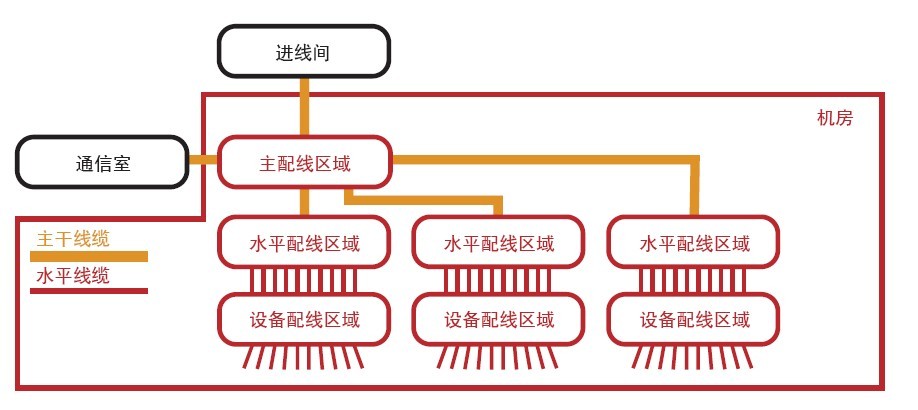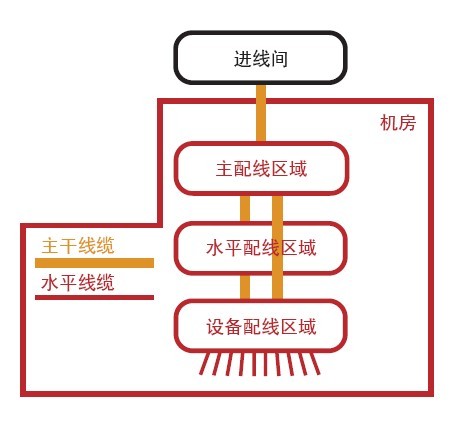Generic Cabling Topology, Performance and Security - CommScope Data Center Guide
Data Center Generic cabling The topology is based on the TIA-568 standard and has been improved for a more centralized environment such as the data center. In general, the horizontal routing area is used as the dividing point between the two main cable types, and between the horizontal and the backbone. Generic cabling includes cross connected distribution frames, terminal modules, jumpers, and cables. It must be emphasized that these components should be regarded as a whole system, and all components should be designed to provide maximum capacity and performance.
The generic cabling of the data center adopts a star topology structure. High speed signals are introduced from the backbone and distributed into each relatively small and short horizontal segment.

Horizontal wiring starts from the panel of distribution frame in the horizontal wiring area and ends at the equipment in the rack. Backbone wiring extends from the horizontal wiring area to the incoming line room. One type of backbone cabling expansion is called centralized backbone, which can be used for long-distance high-speed connections.
Routing distance and performance
TIA-568 standard specifies the maximum working distance of the wiring system based on the minimum performance (interference, bandwidth, etc.) standard requirements when partial loss is allowed at the junction and connector. Routing at the specified maximum transmission distance that meets the standard at the lowest level may lead to bit error. In the case of high-density cabling and high data rate, it is recommended that the cabling system leave more margin on the indicators specified in the standard to ensure performance.
Horizontal cabling - copper vs. fiber
Horizontal wiring is usually shorter in the two types of wiring. TIA-568 defines that the maximum length of horizontal cable is 90 meters (295 feet), and 10 meters (33 feet) are reserved for equipment connection or jumper. The length of the entire horizontal channel is 100 meters (328 feet). Although multimode fiber still keeps growing with relatively high investment, UTP copper cable is still the most suitable cable for horizontal cabling.
Twisted pair cable shall be marked with its grade at the lowest level of performance and defined by category (or international standard class). For example, ultra five (5e) UTPs are a reliable choice for 100 Mb/s transmission, while six UTPs are recommended for 1 Gb/s transmission. The GigaSPEEDX10D solution meets the requirements of Category 6A (also known as EA) draft standards, and can provide 10 Gb/s transmission rate within 100 meters.
For data centers with high transmission rate requirements, such as SAN storage network and NAS network storage, it is more cost-effective to use laser optimized 50 μ m diameter fiber as horizontal cabling now than to upgrade to fiber cabling in the future.
Backbone cabling - fiber solutions
Due to the longer distance and higher speed requirements of backbone cabling, optical fiber has become the preferred medium for backbone cabling. With an economical VCSEL illuminator, various high bandwidth laser optimized optical fibers (including LazrSPEED 150, LazrSPEED 300, and LazrSPEED 550) can provide 10 Gb/s services with the highest cost performance ratio at distances of 150 meters, 300 meters, and 550 meters respectively, meeting and exceeding the requirements of backbone cabling in the data center. Note: For small data centers that need shorter distances, it is also feasible to use GigaSPEED X10D UTP cabling as a 10 Gb/s backbone solution.
Centralized cabling
This is a cabling method that combines backbone and horizontal. The equipment distribution area (EDA) and the main distribution area (MDA) are directly connected together through the continuous cable or in the horizontal distribution area. Considering its distance span (the maximum specified is 300m), laser optimized 50 μ m fiber is recommended.


Fire safety level
Due to the centralized placement of equipment, the cables in the data center are also densely placed. Therefore, it is impractical to lay the communication cable in the pipeline, but it is generally laid in the open trunking under the raised floor. Since communication cables are not wrapped like power cables, the fire rating and performance of cables are very important.
In the United States, communication cables are rated by NEC700 (optical fiber) and NEC800 (copper cable) and divided into three grades - ordinary cables, Riser (backbone) grade flame retardant cables, Plenum grade flame retardant cables. Plenum level flame-retardant cable (rated by OFNP or CMP) is the safest choice for manned environment. When Plenum flame-retardant cable catches fire, its smoke emission and toxic carbon monoxide are lower than Riser cables and ordinary cables. Low smoke halogen-free (LSZH) cables do not contain halogenated plastics. Sometimes they are used in data centers because the smoke generated during combustion does not contain acidic elements that are harmful to equipment in theory. In fact, the smoke emitted by LSZH cables is more than Plenum grade flame-retardant cables, which may cause greater damage.
The horizontal cable can be balanced twisted pair or 50 μ m optical fiber. If your system needs 10 Gb/s now, LazrSPEED fiber is the best choice. If 10 Gb/s may be required, the GigaSPEED X10D UTP solution can well meet the current demand and achieve smooth upgrade. For trunk applications, LazrSPEED is the most suitable solution for trunk distance.
![]()








